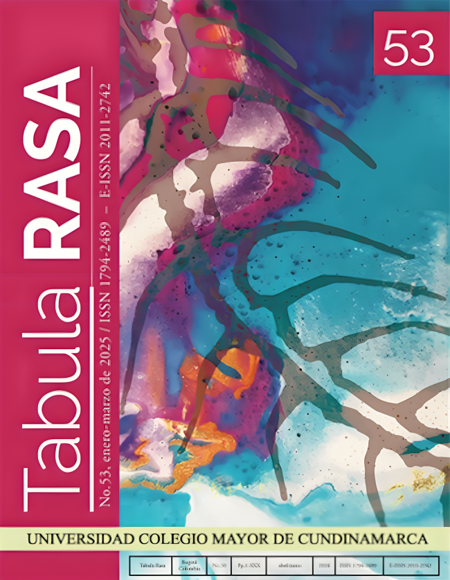Sharing Life with Dogs: Philosophical and Ethical Reflections on their Present and Future
Compartir la vida con perros: reflexiones filosóficas y éticas sobre su presente y su futuro
Show authors biography
This article reviews the main philosophical and ethical constructs that have defined the way humans and non-human animals share world. It focuses on exploring what it means to share home and life with dogs and other animal companions, reflecting through different authors about the main challenges stemming from that circumstance: domestication, anthopomorfism, a dog as a property to someone else, the notion of pet, and the construction of interspecies relationships as vertical, assymetric, and subjugated. Further on, this article advances the idea that giving language and communication to the dog is an unavoidable humbleness exercise to allow them to participate in the construction of the world and to allow symmetric, bi-directional, and horizontal relationships. Finally, we argue that, in the long term, dogs and other animals will not live with us, but today they do as ambassadors of all the other species.
Article visits 3 | PDF visits 0
Downloads
- American Pet Products Association. (2021). Pet industry market size, trends and ownership statistics. https://www.americanpetproducts.org/press_industrytrends.asp
- Ballén, L., Pineda-Marín, C., Sandoval-Escobar, M. & Padrón-Mercado, C. (2021). Significados y prácticas de consumo conspicuo asociados a la posesión de perros criollos o de raza. Acta Colombiana de Psicología, 24(1), 141-153. https://doi.org/10.14718/ACP.2021.24.1.13
- Barchas, D., Melaragni, M., Abrahim, H. & Barchas, E. (2020). The best medicine. Personal pets and therapy animals in the hospital setting. Critical Care Nursing Clinics of North America, 32(2), 167-190. https://doi.org/10.1016/j.cnc.2020.01.002
- Baquedano, S. (2017). Jerarquías especistas en el pensamiento occidental. Eidos, 27, 251- 271. https://www.redalyc.org/journal/854/85451404011/html/
- Bentham, J. ([1780] 2008). Los principios de la moral y la legislación. Claridad
- Ceballos, P. (2010). Desde los ámbitos de enfermería, analizando el cuidado humanizado. Ciencia y Enfermería, 16(1), 31-35. http://dx.doi.org/10.4067/S0717-95532010000100004
- Díaz, M. (2021). Proximidad en el vínculo humano-perro: el rol del antropomorfismo y el antropocentrismo. Tabula Rasa, 40, 279-299. https://doi.org/10.25058/20112742.n40.12
- Díaz, M. (2019). El valor de la vida de los animales de compañía: el vínculo humanoanimal, más allá del especismo y de consideraciones económicas. Revista Latinoamericana de Estudios Críticos Animales, 6(1), 244-276. https://revistaleca.org/index.php/leca/article/view/244
- Du Toit, J. (2016). Is having pets morally permissible? Journal of Applied Philosophy, 33(3), 327-343. https://doi.org/10.1111/japp.12106
- Francione, G. (2008). Animals as persons. Essays on the abolition of animal exploitation. Columbia University Press.
- Francione, G. (1999). El error de Bentham (y el de Singer). Teorema, 18(3), 39-60.https://www.jstor.org/stable/43047319
- Fudge, E. (2014). Pets. Paidós.
- Gobierno de Chile. (10 de marzo del 2022). Primer estudio de población animal en Chile revela que hay 12 millones de perros y gatos con dueños y 4 millones sin supervisión. https://www.gob.cl/noticias/primer-estudio-de-poblacion-animal-en-chile-revela-que-hay-12-millones-de-perros-y-gatos-con-duenos-y-4-millones-sin-supervision/
- Horta, O. (2017). Un paso adelante en defensa de los animales. Plaza y Valdés Editores.
- Horta, O. (2011). La cuestión del mal natural: bases evolutivas de la prevalencia del desvalor. Ágora: Papeles de Filosofía, 30(2), 57-75. https://minerva.usc.es/entities/publication/9574ad80-9e1d-4078-ab22-f40170385fcb
- Humanidades TV. (26 de mayo del 2021). Jornadas internacionales de ética aplicada. Sesión 2. Animales no humanos y medioambiente. [Archivo de video]. YouTube. https://youtu.be/kAiLJwKOLUg
- Jonas, H. (1995). El principio de responsabilidad. Ensayo de una ética para la civilización tecnológica. Editorial Herder.
- Jones, O. (2 de mayo del 2022). 23 pet industry market statistics to know in 2022: Trends, market size and more. PetKeen. https://petkeen.com/pet-industry-statistics-trends-uk/
- Leather, S. R. (2009). Institutional vertebratism threatens UK food security. Trends in Ecology and Evolution, 24(8), 413-414. https://doi.org/10.1016/j.tree.2009.05.002
- Leyton, F. (2015). Literatura básica en torno al especismo y los derechos animales. Revista de Bioética y Derecho, 19, 93-98. https://www.redalyc.org/pdf/783/78339720004.pdf
- Ministerio de Justicia. (9 de abril del 2022). Código penal. Biblioteca del Congreso Nacional de Chile. http://bcn.cl/304yk
- Ministerio de Salud. (2 de agosto del 2017). Ley 21.020 sobre tenencia responsable de mascotas y animales de compañía. Biblioteca del Congreso Nacional de Chile. http://bcn.cl/2s9h3
- Rhodes, L. (2016). New approaches to non-surgical sterilization for dogs and cats: Opportunities and challenges. Reproduction in Domestic Animals, 51(3), 1-5. https://doi.org/10.1111/rda.12862
- Rozzi, R. (2019). ¡Chovinismo taxonómico, no más! Antídotos de Hume, Darwin y la ética biocultural. Environmental Ethics, 41(1), 73-112. https://doi.org/10.5840/enviroethics201941SupplementI34
- Ryder, R. (2004). Speciesism revisited. Think, 2(4), 83-92. doi: https://doi.org/10.1017/S1477175600002840
- Singer, P. ([1975] 1999). Liberación animal. Editorial Trotta.
- Szydlowski, M., Hill, K., Oxley, S. & Hooper, J. (2022). Domestication and domination: human terminology as a tool for controlling otherthanhuman animal bodies. Journal for Human-Animal Studies, 8, 32-55. https://doi.org/10.23984/fjhas.110388
- Torres, M. (2009). Capacidades y derechos de los animales: argumentos a favor de la teoría de M.C. Nussbaum. Dilemata, 1, 33-47. https://www.dilemata.net/revista/index.php/dilemata/article/view/3
- Verdad MVD. (18 de mayo del 2021). Entrevista a Óscar Horta [Archivo de video].YouTube. https://youtu.be/Y7yLyUpe958




